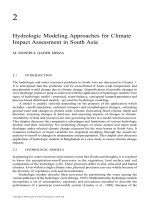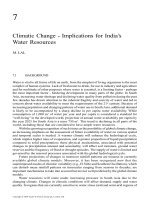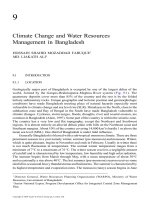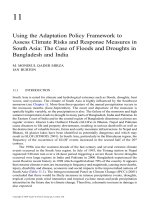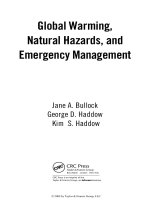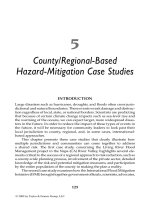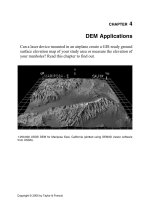GIS for Water Resources and Watershed Management - Chapter 11 doc
Bạn đang xem bản rút gọn của tài liệu. Xem và tải ngay bản đầy đủ của tài liệu tại đây (651.36 KB, 9 trang )
119
CHAPTER 11
Application of GIS and Remote
Sensing for Watershed Assessment
Lloyd P. Queen, Wayne L. Wold, and Kenneth N. Brooks
INTRODUCTION
Located at the western terminus of Lake Superior, the Nemadji River Watershed covers 670
square kilometers in Minnesota (Figure 11.1). Approximately 40% of the area of the Nemadji
Basin occurs in what is termed the Red Clay Area, a band of montmorillonite clays, up to 60 me-
ters in depth. The clays, which are a result of offshore sediment deposits from glacial Lake Duluth,
are highly erodible and prone to mass wasting. The high levels of sediment transported by the Ne-
madji River system adversely affect the designated trout streams in the basin, and deposit an esti-
mated 525,000 metric tons of sediment annually into the Duluth/Superior harbor.
The erosion and sedimentation problems associated with the Nemadji Watershed led to the cre-
ation of the multiagency research and demonstration “Red Clay Project.” This project concluded
that erosion in the red clay area and subsequent transport and sedimentation is a natural process
that has been intensified by forest harvesting, road building, and land-use conversions from forest
to agriculture and open land (Andrews et al., 1980). Forest removal reduced evapotranspiration
rates, resulting in a reduced resistance in soils to shear forces because of increased soil moisture
content. In addition, the weaker root systems of replacement vegetation compared to the original
white pine forests contribute to soil mass movement. The loss of large woody debris in stream
channels also is thought to have reduced stream channel stability. In 1991, the conclusions of the
Red Clay Project were reassessed, focusing attention on watershed factors that may be of greatest
importance in correcting or mitigating the problem of soil mass wasting in the Nemadji basin. This
chapter discusses the results of this reassessment.
SETTING
Soil mass wasting is the process of downslope movement of soil that consists of shear stress
and displacement along surfaces that are either visible or that can reasonably be inferred
(Huang,1983). Movement is thought to be the result of three contributing factors: (1) the high
transportability rate potential of the soils; (2) the high soil moisture content; and (3) the absence of
strong root systems to hold the soil in place. The Nemadji River Watershed exhibits excessive
amounts of soil mass wasting (hereafter referred to as slumping). Most evident in the watershed
are the chiefly rotational slumps that occur on hillslopes in the stream valleys and along the
streams themselves. These slumps are suspected as a significant source of sediment to both the
tributaries and the main stem of the Nemadji (Andrews et al.,1980).
The purpose of this research was to relate the frequency of slumping to watershed characteris-
© 2003 Taylor & Francis
Chapters 1, 3, 5 & 6 © American Water Resources Association; Chapter 13 ©
Elsevier Science; Chapter 14 © American Society for Photogrammetry and Remote Sensing
120 GIS FOR WATER RESOURCES AND WATERSHED MANAGEMENT
tics that potentially have the greatest effect on soil mass wasting. These watershed characteristics
were considered independent predictor variables of the dependent variable, frequency of slump-
ing. Secondarily, the research was to determine data requirements for efficient and cost-effective
development of a Geographic Information System (GIS) that could be applied for future water-
shed planning and management.
Based on previous work, this research analyzed the following nine watershed variables thought
to affect soil mass wasting: stream channel gradient, time of concentration, stream length, degree
of slope, total length of roads in the subwatershed, watershed area, percent coniferous cover, per-
cent deciduous cover, and total forested area. Each of these variables was examined with fre-
quency of slump sites in each of nine subwatersheds (Figure 11.2).
Fortunately, the relationships between forest cover and water yield have been the subject of
considerable research. Results from research conducted in humid-temperate regions indicate that,
in general, water yield is considerably greater under hardwoods than under conifers due to de-
creased interception losses and the longer dormant period of deciduous species (Swank and Dou-
glas, 1974).
Figure 11.1. Nemadji Basin location map.
© 2003 Taylor & Francis
Chapters 1, 3, 5 & 6 © American Water Resources Association; Chapter 13 ©
Elsevier Science; Chapter 14 © American Society for Photogrammetry and Remote Sensing
APPLICATION OF GIS AND REMOTE SENSING FOR WATERSHED ASSESSMENT 121
Increased streamflow provides additional energy for streambank degradation. Logging or thin-
ning forests, converting from deep rooted to shallow rooted vegetation, or changing vegetative
cover from one with a high interception capacity to one of lower capacity, all have been shown to
increase water yield (Brooks et al., 1991).
Studies in Minnesota by Verry (1986) indicate that annual water yield increases and that aver-
age annual peak flows can double after cutting upland forests. As the amount of nonforested area
in a basin increases, one would expect water yield to increase and with it, higher streamflows with
higher velocities and energy. Such conditions could promote the undercutting of slopes and conse-
quently, streambank slumpage. Streambank undercutting, pervasive in the highly erosive red
clays, leaves the banks susceptible to slides and slumping. Such effects could be greater following
the removal of conifers than hardwoods.
Figure 11.2. Map showing subwatersheds within the Nemadji Basin.
© 2003 Taylor & Francis
Chapters 1, 3, 5 & 6 © American Water Resources Association; Chapter 13 ©
Elsevier Science; Chapter 14 © American Society for Photogrammetry and Remote Sensing
In addition to the role of forest cover type on stream flow, the root strength of different species
also can influence soil mass wasting (Sidle, 1985; Abe and Ziemer, 1991). The loss of tree roots
diminishes resistance to slumping. On steep slopes bordering streams this combination induces
soil creep and slumping. According to the Red Clay Project, high (prefrost) soil moisture levels
can be positively correlated with the rate of spring soil mass soil wasting along stream banks (An-
drews et al.,1980). Conifers, which transpire later into the fall and retain their interception capac-
ity year-round, should reduce soil moisture during this critical period.
The dependent variable, slump frequency, was determined by tabulating areas where the min-
eral soil was exposed due to slumping; these sites were identified and mapped from high-resolu-
tion low-altitude aerial photographs. Frequency of slumps served as the primary indicator of the
relative rate of erosion in each subbasin. In this application, slump frequency was evaluated for
both entire subwatersheds and for a series of five discrete buffer zones surrounding each of the
streams in those subwatersheds.
APPROACH
Pronounced differences in stream sediment concentrations and related turbidity exist among
streams in the Nemadji Basin. To encompass the range of sediment-turbidity conditions, three sub-
watersheds were selected from each of three turbidity classes, low, moderate, and highly turbid.
Classifications based on turbidity were verified using suspended sediment samples and discharge
data collected during April and October 1993 and April 1994 (Table 11.1). Suspended sediment,
turbidity, and streamflow discharge were measured for both upstream and downstream locations
from each of the nine streams (USGS, 1977) at the locations shown in Figure 11.3 (see color
section).
Each of the nine predictor variables and maps of slump sites were compiled for each of the nine
subbasins in a vector-based GIS. A vector model was chosen for data development and analysis
because these systems provide an excellent platform for development and mapping of point (e.g.,
slump sites), line (e.g., streams), and polygon (e.g., forest stands) data as well as for spatial data
analysis. Additionally, local and regional management organizations had previously adopted vec-
tor GIS for in-house use. Design criteria for the Nemadji GIS data are map themes at a scale of
1:24,000, with Universal Transverse Mercator (UTM) Zone 15 coordinates applied to all spatial
entities, built using conic projections. Base maps for the GIS were derived from existing USGS
7.5 minute quadrangle maps. Quad maps also served as source data for topographic (slope) data,
stream locations, and stream gradient estimates. The generation of data themes, the crux of most
GIS efforts, is described in the next two sections.
The three primary hydrologic themes are stream gradient, time of concentration, and watershed
area. All blue-line (perennial and intermittent) streams were digitized from the USGS 1:24,000
quadrangle maps (Figure 11.4, see color section). The change in elevation from the headwaters to
the mouth was taken directly from the quadrangle maps and divided by the length of the stream to
determine gradient. Time of concentration was estimated using the Kirpich formula as reported by
Gray (1970).
The primary terrestrial variables are slope, stream length, road length, and land cover; and the
dependent variable, slump sites. Slope maps were interpolated from a series of contour lines digi-
tized as points from the USGS quads, and a triangulated irregular network (TIN) algorithm was
used to create an interpolated slope coverage for all basins. Mean slope was then calculated for
each basin (Figure 11.4). The roads theme was acquired in digital vector format from the Min-
nesota Department of Transportation.
Stereo pairs of conventional color photographs, acquired in May 1992, were used to identify
122 GIS FOR WATER RESOURCES AND WATERSHED MANAGEMENT
© 2003 Taylor & Francis
Chapters 1, 3, 5 & 6 © American Water Resources Association; Chapter 13 ©
Elsevier Science; Chapter 14 © American Society for Photogrammetry and Remote Sensing
Table 11.1. Summary of Basin Characteristics
High Turbidity Moderate Turbidity Low Turbidity
Gradient Discharge S. Sediment TOC Stream Length
No. Mean Slope Road Length Total Area % % %
Variable (m/km) (L/s)
a
(ppm)
a
(hr) (km) Slumps (%) (km) (ha) Conifer Deciduous Forested
Mud 5.3 17–382 6–35 5.37
2.22 45 52 49.2 3889 21 53 74
Rock 7.0 6–49 33–127 3.57 13.8 39 57 22.0 1830 22 33 55
Deer 7.9 54–106 43–105 3.25 11.1 45 50 13.5 2068 18 50 68
Skunk 5.7 26–371 6–30 3.95 14.3 27 66 33.3 2680 23 47 70
Noname 13.2 4–86 10–73 1.53
5.5 25 41 14.2 750 29 52 81
Clear 5.9 19–47 5–24 2.98 10.3 9 18 11.6 1031 29 44 73
Silver 9.1 98–193 1–17 2.13 6.9 2 36 11.7 1234 24 58 82
Little 7.8 66–357 1–11 4.71 19.5 13 52 18.7 3224 18 77 95
Net 12.3 36–95 4–12 3.38 14.3 25 49 11.3 1631 27 49 76
Stateline
a
Ranges are taken from three sampling dates (4/93, 10/93, and 4/94) and ar
e reported for the downstream sampling point only.
© 2003 Taylor & Francis
Chapters 1, 3, 5 & 6 © American Water Resources Association; Chapter 13 ©
Elsevier Science; Chapter 14 © American Society for Photogrammetry and Remote Sensing
and map slump sites. Photos were acquired from a helicopter platform using a 35 mm format cam-
era. Negatives were printed at a nominal scale of 1:5,000, and interpreted using a 3-power mirror
stereoscope. Land cover was mapped from stereo-pairs of 1:24,000 NHAP photographs into four
land cover classes: (1) agricultural/open land; (2) coniferous forest; (3) deciduous forest; and (4)
open water. NHAP prints were manually interpreted under magnification using a 0.5 hectare min-
imum mapping unit. Digital files of land cover were plotted and visually field-checked for accu-
racy of the cover typing (Figure 11.5, color section).
Slump sites were located on the 1:5,000 scale photos using a magnifying stereoscope. After
intensive field checks (using a 75% sample) for accuracy and completeness, sites were entered
into the GIS. Large-scale photos were required for accurate interpretation and each slump site
could only be represented as a point location. However, due to differences in scale between the
photos and the base map, it was difficult to locate the slumps precisely on the base map. Man-
ual editing was employed to reposition the sites in some cases; as a result slump sites were esti-
mated to be located to within 60 meters of their true location at a scale of 1:24,000 (Figure 11.6,
color section).
The end result of data compilation was a 1:24,000 scale GIS for all of the nine subwatersheds.
Values of land cover class area, ratio measures of percent cover, and lengths and values for the
other variables as calculated within the GIS are reported in Table 11.1. The final data preprocess-
ing step was to create data on buffer strips to examine the role of proximity of forest cover to
stream channel as a covariate for the independent variables. To assess this effect, five buffer zones
were defined along each stream channel, representing buffer strips of 10, 20, 40, 80, and 300 me-
ters on each side of the stream.
Finally, a series of linear regressions were performed based on the frequency counts of soil
mass movement sites in each basin and the measurements of the independent variables from the
GIS.
RESULTS
The pattern of discharge follows the expected annual trend of highest flows occurring in April,
with decreasing flows from August to October. The highest discharge gauged was just over 382
liters per second, measured in April on Skunk Creek. Although the low sample size prevents deri-
vation of sediment rating curves and the use of statistical tests, there is no apparent difference in
the observed discharges between the three classes that were grouped on the basis of stream turbid-
ity. Overall, the more highly turbid streams (e.g., Mud, Rock, and Deer Creeks) not only had
higher suspended sediment values, but they also exhibited more load variability over the sampling
period.
Stream gradients are not higher in the more turbid streams (Table 11.1), and mean slope values
are scarcely higher (but not statistically significant) for the more turbid streams. Total subwater-
shed areas vary from 3,889 hectares for Mud Creek to 750 hectares for Noname Creek; stream
length and time of concentration are proportional to the total subwatershed areas for all of the
basins. Mud, Rock, and Skunk Creeks have the highest values for total lengths of roads, and all are
classified as having high to moderate turbidity. However, it is possible that road building may have
its greatest effect at specific road cuts and bridge locations where slope stability was reduced.
Stream gradient was not significantly correlated to the number of slump sites and was relatively
constant along the profiles. In a similar fashion, stream length did not exhibit a geographic pattern
of variability, nor was it correlated to slump frequency. Time of concentration, conceptually, is an
indication of the time it takes for water to travel from the hydraulically most distant point of a wa-
tershed to the mouth of the primary stream. The less the amount of time required, the faster a
124 GIS FOR WATER RESOURCES AND WATERSHED MANAGEMENT
© 2003 Taylor & Francis
Chapters 1, 3, 5 & 6 © American Water Resources Association; Chapter 13 ©
Elsevier Science; Chapter 14 © American Society for Photogrammetry and Remote Sensing
given stream will flow and thus the greater the energy potential for streamflow through the stream
channel. No significant linear relationship was found between time of concentration and the num-
ber of observed slumps. However, there is little difference in time of concentration values among
the different subwatersheds (Table 11.1).
The relative proportions of land-cover types varies considerably for the subwatersheds. The
northern-most subwatersheds (Mud, Rock, and Deer Creeks) generally have lower forest cover
area and higher suspended sediment concentrations (Table 11.1) than those subwatersheds to the
south. Deciduous forest was the dominant forest type in all of the subwatersheds, with a maximum
in the Little Net subwatershed of 77% and a minimum of 33% in Rock Creek basin. There was no
strong geographic pattern of differences in the distribution of coniferous forest from one subwa-
tershed to another.
As the width of the buffer zones increases, generally we see a reduction in the proportion of
conifer cover to deciduous cover as a percentage of the area of the buffer. Across all nine subwa-
tersheds it appeared that conifer cover types tended to occur most frequently in near-stream loca-
tions. When 300 meter widths were considered, the buffer strip usually extended to the ridgetop.
This in part explains the increasing proportion of nonforested (agricultural and open) land at the
300 meter width.
The regression analysis of watershed characteristics and slump frequency yielded only one sig-
nificant linear relationship. When the regressions were repeated for all of the buffer strip widths
for all independent variables, again only one relationship was significant. In both cases forest
cover percent was the significant variable. Note that the highest turbidity streams tend to have the
most slump sites and a smaller relative proportion of forested land. Yet, low turbidity and high tur-
bidity streams occur in watersheds with about the same percentage of conifer cover. The need to
consider interactions of other variables and the distribution of the conifer cover in the basin is
clear.
The percent slope of hillsides is generally assumed to be a significant covariate when examin-
ing causes of soil mass wasting. As percent slope increases, the effects of other contributing fac-
tors are amplified. These data show that as the mean slope of a subwatershed increases, there is a
tendency for the number of slumps to increase as well. Although mean basin slope was not a sig-
nificant predictor variable, it was noted that slope effects may be site specific, and when averaged
over a large area, this effect was not apparent. Percent slope at each slump site, or the configura-
tion of the hillslope associated with each slump site, could provide a different result.
The relationship between the total length of roads within each subwatershed and the number of
slumps within that subwatershed was not significant. The larger the watershed, the greater the road
length contained within it. Thus, the length of roads within a subwatershed was correlated with the
size of the subwatersheds and not with the number of slumps. Results show the lack of a signifi-
cant linear relationship of area to the dependent variables. As with slope percent, we suspect that
roads need to be investigated on a site specific basis. The effect of roads most likely enhances
slump occurrence at or very near the road cut itself. Because they were not mapped in this study,
the impact of logging roads and skid trails remains untested.
On a subwatershed level, the occurrence of slumps generally did not diminish with increasing
percent of conifer cover. There is a significant inverse relationship between the amount of total
forest cover in a subwatershed and the number of slumps observed. As the amount of total forested
area in a subwatershed increases the number of observed slumps decreases. However, when the
buffer zones were analyzed this relationship did not persist. In fact, the only significant relation-
ship found when repeating all regressions for all variables and all five buffer zone widths was the
percent of coniferous cover within 80 meters of the stream channel. This might suggest that the
percentage of the total watershed area in open/agricultural land affects the number of slumps, but
APPLICATION OF GIS AND REMOTE SENSING FOR WATERSHED ASSESSMENT 125
© 2003 Taylor & Francis
Chapters 1, 3, 5 & 6 © American Water Resources Association; Chapter 13 ©
Elsevier Science; Chapter 14 © American Society for Photogrammetry and Remote Sensing
the effect of location, or distribution, of the nonforested area in proximity to stream channels could
not be tested at the scale and resolution of this study.
Study Implications
The GIS created for the basin contains maps of slump locations, land cover conditions, slope,
and other characteristics for portions of the Nemadji River Watershed. In addition to serving as a
data management tool, the GIS was used as the basis for data development and analysis. As a re-
sult of building GIS capability, several relationships between physical watershed characteristics
could be examined systematically and efficiently.
Land cover was disproportionately distributed between the four land cover classes. Deciduous
forest cover was more abundant in the upper reaches of the subwatersheds than in the lower
reaches. In all subwatersheds, there is more deciduous cover than coniferous cover. Progressing
downstream, the amount of conifer cover increased, especially within the stream valleys them-
selves. Much of the conifer cover was balsam fir (Abies balsamea) and spruce (Picea sp.) rather
than the larger and deeper rooted white pine (Pinus strobus) that was the dominant conifer at the
turn of the century. Conversely, the amount of open/agricultural area decreased from the upper to
lower reaches of the stream. When large open areas occurred from the ridgetop leading down to a
stream, there was generally a higher frequency of slumps in association with the open area.
Slope was identified as a significant covariate with slump locations from the Red Clay Project
and other sources. Although our results did not show a significant linear correlation between per-
cent slope and slope failure in the subwatersheds, there were plausible explanations. The mean
slope and the number of slumps tended to increase closer to the mouth of the stream. Coinciden-
tally, the percentage of conifer cover increased in lower areas as well. While the reason for the in-
crease in conifer cover downstream was not known, it was possible that it would be more difficult
to harvest on steep slopes.
Furthermore, the type of coniferous species present, which was not quantified from the aerial
photographs, can influence slope stability through differences in root strength and rates of transpi-
ration (for example, balsam fir is shallow-rooted and would not have the same slope stability ef-
fects of white pine or red pine). These two effects, among others, greatly complicate the analysis
of cover type by slope class.
CUMULATIVE EFFECTS
The occurrence of soil mass wasting in the Nemadji Basin most likely was an expression of the
cumulative effects of land use activities that have taken place over the past century. The removal
of white pine forests at the turn of the century, the accompanying expansion of agricultural devel-
opment, road construction, and the conversion from white pine to aspen-dominated forests all af-
fected processes that would be expected to reduce slope and channel stability. The GIS approach
allowed the consideration of individual variables as they might affect slumpage; however, the cu-
mulative effects of all these activities over the watershed was not easily quantified and may be a
situation of the total being “greater than the sum of the individual parts.”
The removal of white pine and the subsequent replacement by either farmland or aspen forests
would be expected to reduce slope strength because of loss of root strength on slopes. Overall re-
ductions in evapotranspiration, leading to wetter soils, would increase soil stress. The loss of large
woody debris in the channels would be expected to reduce channel stability, which coupled with
increased water yield and stormflow volumes and peaks, would promote greater channel scour and
streambank erosion. Road construction in the basin adds to these problems. Such processes occur-
126 GIS FOR WATER RESOURCES AND WATERSHED MANAGEMENT
© 2003 Taylor & Francis
Chapters 1, 3, 5 & 6 © American Water Resources Association; Chapter 13 ©
Elsevier Science; Chapter 14 © American Society for Photogrammetry and Remote Sensing
APPLICATION OF GIS AND REMOTE SENSING FOR WATERSHED ASSESSMENT 127
ring at the toe of the slope in these deeply incised channels would enhance soil slumps. After
nearly 100 years, this watershed system still expresses, through excessive channel erosion,
slumpage, and the resulting sediment loading, the cumulative effects of land use change. If we in-
tend to develop models that help explain the cause-and-effect relationships of these systems, a bet-
ter overall assessment of these cumulative effects is needed.
Because the percent of forested area was inversely related to a greater frequency of soil slumps,
management should logically be aimed at increasing and maintaining forest cover in the water-
shed. Although these results could not identify preferred species for controlling slumps, the litera-
ture suggests that certain species such as white pine would be expected to provide more slope
stability than other species such as aspen or birch. A more detailed look at species suitable for
slope stability is warranted.
The results from this study underscore the need for future research into hillslope hydrology and
fluvial processes in the Nemadji Watershed. This study points to certain factors that appear to be
related to soil mass wasting and suspended sediment relationships in the Nemadji. Yet no defini-
tive results exist to specifically address the actual relationships of water flow and subsequent soil
mass wasting processes. More extensive streamflow data are needed in concert with hillslope
process studies. Rainfall and snowmelt events over a range of magnitudes need to be studied so
that we can better understand temporal relationships. In fact, the role that large rainfall events play
in erosion is as yet unresearched in the Nemadji. Given these results and the availability of the GIS
database, a process has been developed that enables managers to continue to examine watershed
features and to monitor and track cumulative effects across this critical watershed.
REFERENCES
Abe, K., and R.R. Ziemer, 1991, Effect of tree roots on shallow-seated land slides. In Proceedings,
IUFRO Technical Session on Geomorphic Hazards in Managed Forests. USDA Forest Service
Gen. Tech. Rep. PNW–130, pp. 11–20.
Andrews, S.C., R.G. Christensen, and C.D. Wilson, 1980. Impact of Nonpoint Pollution Control
on Western Lake Superior. Red Clay Project Final Report. U.S. Environmental Protection
Agency Report, EPA 905/9-79-002-B.
Brooks, K., P. Folliott, H. Gregersen, and J. Thames, 1991. Hydrology and the Management of
Watersheds. Iowa State University Press, Ames, IA.
Gray, D.M., Ed., 1970. Handbook on the Principles of Hydrology. Reprint. National Research
Council of Canada. Port Washington: Water Information Center, Inc.
Huang, Y., 1983. Stability Analysis of Earth Slopes. Van Nostrand Reinhold Company, Inc., New
York, NY.
Sidle, R.C., 1985. Factors influencing the stability of slopes. In Proceedings, Workshop on Slope
Stability: Problems and Solutions in Forest Management. USDA Forest Service Gen. Tech.
Rep. PNW-180, pp. 17–25.
Swank, W.T., and J.E. Douglas, 1974. Streamflow greatly reduced by converting deciduous hard-
wood stands to pine. Science, 185(4154):857–859.
United States Geological Survey, 1977. Sediment. In The Handbook of Recommended Methods for
Water Data Acquisition. United States Geological Survey, Reston, VA, Chap. 3.
Verry, E.S. 1986. Forestry harvesting and water: The lake states experience. Water Resources Bul-
letin, 22(6):1039–1047.
© 2003 Taylor & Francis
Chapters 1, 3, 5 & 6 © American Water Resources Association; Chapter 13 ©
Elsevier Science; Chapter 14 © American Society for Photogrammetry and Remote Sensing
